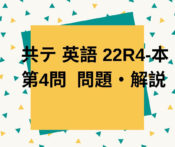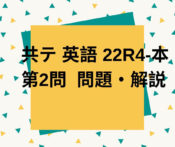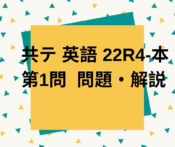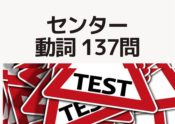共通テスト英語2022(令和4) 第5問 問題&詳細解説
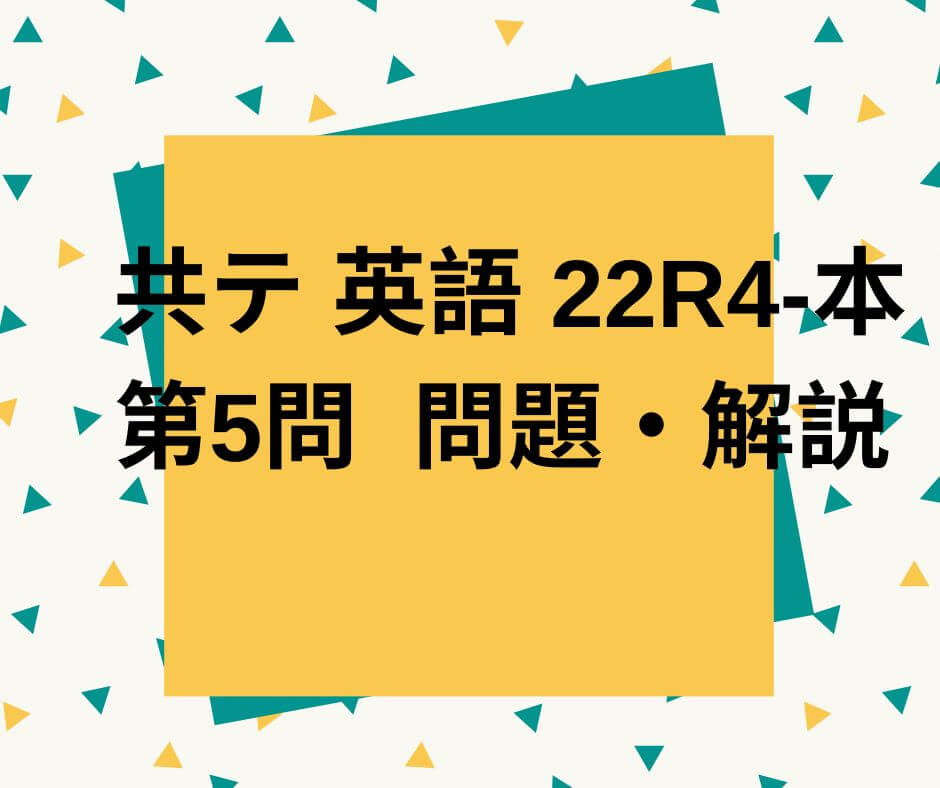
大手予備校で中1から高3の基礎クラスから東大クラスまでほとんどのクラスを担当しました。映像授業にも多数出演経験あり。
元東海大非常勤講師。
「大学入試英語解く得!」は最高PV数 34,212 / 日
質・量ともに日本一分かりやすい大学入試英語対策ページを目指します!
資格:英検一級、通訳案内士(英語)、TOEIC950点
趣味:海外旅行、食べ歩き
特技:将棋アマ六段 (全国レーティング選手権優勝 1998)
元技術翻訳者、元富士通
今回の内容
英語2022 (令和4) 第5問-問題
In your English class, you will give a presentation about a great inventor. You found the following article and prepared notes for your presentation.
Who invented television? It is not an easy question to answer. In the early years of the 20th century, there was something called a mechanical television system, but it was not a success. Inventors were also competing to develop an electronic television system, which later became the basis of what we have today. In the US, there was a battle over the patent for the electronic television system, which attracted people’s attention because it was between a young man and a giant corporation. This patent would give the inventor the official right to be the only person to develop, use, or sell the system.
Philo Taylor Farnsworth was born in a log cabin in Utah in 1906. His family did not have electricity until he was 12 years old, and he was excited to find a generator ― a machine that produces electricity ― when they moved into a new home. He was very interested in mechanical and electrical technology, reading any information he could find on the subject. He would often repair the old generator and even changed his mother’s hand-powered washing machine into an electricity-powered one.
One day, while working in his father’s potato field, he looked behind him and saw all the straight parallel rows of soil that he had made. Suddenly, it occurred to him that it might be possible to create an electronic image on a screen using parallel lines, just like the rows in the field. In 1922, during the spring semester of his first year at high school, he presented this idea to his chemistry teacher, Justin Tolman, and asked for advice about his concept of an electronic television system. With sketches and diagrams on blackboards, he showed the teacher how it might be accomplished, and Tolman encouraged him to develop his ideas.
On September 7, 1927, Farnsworth succeeded in sending his first electronic image. In the following years, he further improved the system so that it could successfully broadcast live images. The US government gave him a patent for this system in 1930.
However, Farnsworth was not the only one working on such a system. A giant company, RCA (Radio Corporation of America), also saw a bright future for television and did not want to miss the opportunity. They recruited Vladimir Zworykin, who had already worked on an electronic television system and had earned a patent as early as 1923. Yet, in 1931, they offered Farnsworth a large sum of money to sell them his patent as his system was superior to that of Zworykin’s. He refused this offer, which started a patent war between Farnsworth and RCA.
The company took legal action against Farnsworth, claiming that Zworykin’s 1923 patent had priority even though he had never made a working version of his system. Farnsworth lost the first two rounds of the court case. However, in the final round, the teacher who had copied Farnsworth’s blackboard drawings gave evidence that Farnsworth did have the idea of an electronic television system at least a year before Zworykin’s patent was issued. In 1934, a judge approved Farnsworth’s patent claim on the strength of handwritten notes made by his old high school teacher, Tolman.
Farnsworth died in 1971 at the age of 64. He held about 300 US and foreign patents, mostly in radio and television, and in 1999, TIME magazine included Farnsworth in Time 100: The Most Important People of the Century. In an interview after his death, Farnsworth’s wife Pem recalled Neil Armstrong’s moon landing being broadcast. Watching the television with her, Farnsworth had said, “Pem, this has made it all worthwhile.” His story will always be tied to his teenage dream of sending moving pictures through the air and those blackboard drawings at his high school.
Your presentation notes :
Philo Taylor Farnsworth (1906-1971)
- ( 30 ) -
Early Days
- born in a log cabin without electricity
- ( 31 )
- ( 32 )
Sequence of Key Events
( 33 )
( 34 )
Farnsworth successfully sent his first image.
( 35 )
( 36 )
RCA took Farnsworth to court.
Outcome
- Farnsworth won the patent battle against RCA thanks to ( 37 ).
Achievements and Recognition
- Farnsworth had about 300 patents.
- TIME magazine listed him as one of the century’s most important figures.
- ( 38 )
問1 Which is the best subtitle for your presentation? ( 30 )
① A Young Inventor Against a Giant Company
② From High School Teacher to Successful Inventor
③ Never-Ending Passion for Generating Electricity
④ The Future of Electronic Television
問2 Choose the best two options for ( 31 ) and ( 32 ) to complete Early Days. (The order does not matter.)
① bought a generator to provide his family with electricity
② built a log cabin that had electricity with the help of his father
③ enjoyed reading books on every subject in school
④ fixed and improved household equipment for his family
⑤ got the idea for an electronic television system while working in a field
問3 Choose four out of the five events (①~⑤) in the order they happened to complete Sequence of Key Events.
( 33 ) →( 34 ) →( 35 )→( 36 )
① Farnsworth rejected RCA’s offer.
② Farnsworth shared his idea with his high school teacher.
③ RCA won the first stage of the battle.
④ The US government gave Farnsworth the patent.
⑤ Zworykin was granted a patent for his television system.
問4 Choose the best option for ( 37 ) to complete Outcome.
① the acceptance of his rival’s technological inferiority
② the financial assistance provided by Tolman
③ the sketches his teacher had kept for many years
④ the withdrawal of RCA from the battle
問5 Choose the best option for ( 38 ) to complete Achievements and Recognition.
① He and his wife were given an award for their work with RCA.
② He appeared on TV when Armstrong’s first moon landing was broadcast.
③ His invention has enabled us to watch historic events live.
④ Many teenagers have followed their dreams after watching him on TV.
英語2022(令和4) 第5問-解答・解説
第5問 問1 解答・解説
問1 Which is the best subtitle for your presentation? ( 30 ) あなたのプレゼンテーションに最も適当なサブタイトルはどれか。( 30 )
① A Young Inventor Against a Giant Company 巨大企業と戦う若い発明家
② From High School Teacher to Successful Inventor 高校の教師から成功した発明家へ
③ Never-Ending Passion for Generating Electricity 発電に対する果てしない情熱
④ The Future of Electronic Television 電子テレビの未来
第一段落中頃に
In the US, there was a battle over the patent for the electronic television system, which attracted people’s attention because it was between a young man and a giant corporation.
「アメリカでは電子テレビシステムの特許を巡る争いがあり、それが若者と巨大企業の間のことだったので人々の関心を惹きつけた」とある。
また、この特許を巡る戦いの話は第四段落から第六段落にも出てくるのに副題にふさわしい。①が正解。
第5問 問2 解答・解説
問2 Choose the best two options for ( 31 ) and ( 32 ) to complete Early Days. (The order does not matter.) 「幼少期」を完成させるために ( 31 )と( 32 )に当てはまる最も適当な選択肢を2つ選びなさい。(順序は問わない)
① bought a generator to provide his family with electricity 家族に電気を供給するために発電機を購入した
② built a log cabin that had electricity with the help of his father 父親の助けを借りて電気のある丸太小屋を建てた
③ enjoyed reading books on every subject in school 学校であらゆる教科の本を読むことを楽しんだ
④ fixed and improved household equipment for his family 家族のために家庭の道具を修理し改良した
⑤ got the idea for an electronic television system while working in a field 畑で働いている間に電子テレビシステムのアイデアを思いついた
第二段落最終文に
He would often repair the old generator and even changed his mother’s hand-powered washing machine into an electricity-powered one.
「彼はよく古い発電機を修理したり、母の手動の洗濯機を電気洗濯機に変えたりした」とあるので④が該当する。
また、第三段落の第2文の
Suddenly, it occurred to him that it might be possible to create an electronic image on a screen using parallel lines, just like the rows in the field.
「突然、畑の列とちょうど同じように、平行線を使って画面上に電子画像を作成できるかもしれないという考えが彼の頭に浮かんだ。」が⑤に該当する。
第5問 問3 解答・解説
問3 Choose four out of the five events (①~⑤) in the order they happened to complete Sequence of Key Events. 「重要な出来事の順序」を完成させるために、5つの出来事(①~⑤)の中からそれらが起こった順に4つ選びなさい。
( 33 ) →( 34 )→( 35 )→( 36 )
②→⑤→④→①
① Farnsworth rejected RCA’s offer. ファーンズワースはRCAの申し出を拒否した。
② Farnsworth shared his idea with his high school teacher. ファーンズワースは高校の先生と彼の考えを共有した。
③ RCA won the first stage of the battle. RCAは戦いの第1段階で勝利した。
④ The US government gave Farnsworth the patent. アメリカ政府はファーンズワースに特許を与えた。
⑤ Zworykin was granted a patent for his television system. ズウォーリキンは彼のテレビシステムに対する特許を与えられた。
年号で考えると分かりやすい。
①は第五段落に1931年と、②は第三段落に1922年と、④は第四段落に1930年と、⑤は第五段落に1923年と書かれている。
よって②→⑤→④→①の順になる。
なお、③は表の一番下に書かれている RCA took Farnsworth to court. の後の話だから選択できない。
第5問 問4 解答・解説
問4 Choose the best option for ( 37 ) to complete Outcome. 「結果」を完成させるために( 37 )に当てはまる最も適当な選択肢を選びなさい。
① the acceptance of his rival’s technological inferiority ライバルが技術的に劣っている事の受け入れ
② the financial assistance provided by Tolman トールマンによって提供された資金援助
③ the sketches his teacher had kept for many years 彼の先生が長年保管していたスケッチ
④ the withdrawal of RCA from the battle RCAが戦いから撤退
第六段落最終文に
In 1934, a judge approved Farnsworth’s patent claim on the strength of handwritten notes made by his old high school teacher, Tolman.
「1934年、裁判官は彼の昔の高校教師であるトールマンによって作成された手書きのメモを根拠にファーンズワースの特許の主張を認めた。」とあるので、③が正解。
①②④は記述なし。
第5問 問5 解答・解説
問5 Choose the best option for ( 38 ) to complete Achievements and Recognition. 「成果と認識」を完成させるために( 38 )に当てはまる最も適当な選択肢を選びなさい。
① He and his wife were given an award for their work with RCA. 彼と妻は、RCAとの彼らの仕事に対して賞を与えられた。
② He appeared on TV when Armstrong’s first moon landing was broadcast. アームストロングの最初の月面着陸が放送された時、彼はテレビに出演した。
③ His invention has enabled us to watch historic events live. 彼の発明のおかげで私たちは歴史的な出来事を生で見ることができた。
④ Many teenagers have followed their dreams after watching him on TV. 多くの10代の若者は、テレビで彼を見た後に自分たちの夢を追いかけている。
In an interview after his death, Farnsworth’s wife Pem recalled Neil Armstrong’s moon landing being broadcast. Watching the television with her, Farnsworth had said, “Pem, this has made it all worthwhile.”
「彼が亡くなった後、ファーンズワースの妻ペムは、ニールアームストロングの月面着陸が放送されたことを覚えていた。ファーンズワースは彼女と一緒にテレビを見ながら、「ペム、このおかげでその全てが価値のあるものになった」と言った。」
「その全て」が「彼がそれまでにやってきたこと」と考えられるので③が正解。なお、歴史的な出来事とはもちろんニールアームストロングの月面着陸のこと。
①②④は記述なし。
大手予備校で中1から高3の基礎クラスから東大クラスまでほとんどのクラスを担当しました。映像授業にも多数出演経験あり。
元東海大非常勤講師。
「大学入試英語解く得!」は最高PV数 34,212 / 日
質・量ともに日本一分かりやすい大学入試英語対策ページを目指します!
資格:英検一級、通訳案内士(英語)、TOEIC950点
趣味:海外旅行、食べ歩き
特技:将棋アマ六段 (全国レーティング選手権優勝 1998)
元技術翻訳者、元富士通
